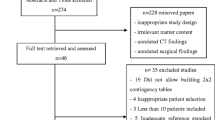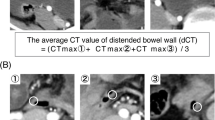Abstract
Introduction
Bowel wall thickening is commonly observed in liver cirrhosis, but few studies have explored its impact on the long-term outcomes of patients with cirrhosis.
Methods
Overall, 118 patients with decompensated cirrhosis were retrospectively enrolled, in whom maximum wall thickness of small bowel, ascending colon, transverse colon, descending colon, sigmoid colon, and rectum could be measured in computed tomography (CT) images. X-tile software was employed to determine the best cut-off values of each segment of bowel wall thickness for predicting the risk of further decompensation and death. Cumulative rates of further decompensation and death were calculated by Nelson–Aalen cumulative risk curve analyses. Predictors of further decompensation and death were evaluated by competing risk analyses. Sub-distribution hazard ratios (sHRs) were calculated.
Results
Cumulative rates of further decompensation were significantly higher in patients with wall thickness of ascending colon ≥ 11.7 mm (P = 0.014), transverse colon ≥ 3.2 mm (P = 0.043), descending colon ≥ 9.8 mm (P = 0.035), and rectum ≥ 7.2 mm (P = 0.045), but not those with wall thickness of small bowel ≥ 8.5 mm (P = 0.312) or sigmoid colon ≥ 7.1 mm (P = 0.237). Wall thickness of ascending colon ≥ 11.7 mm (sHR = 1.70, P = 0.030), transverse colon ≥ 3.2 mm (sHR = 2.15, P = 0.038), and rectum ≥ 7.2 mm (sHR = 2.38, P = 0.045) were independent predictors of further decompensation, but not wall thickness of small bowel ≥ 8.5 mm (sHR = 1.19, P = 0.490), descending colon ≥ 9.8 mm (sHR = 1.53, P = 0.093) or sigmoid colon ≥ 7.1 mm (sHR = 0.63, P = 0.076). Small bowel, ascending colon, transverse colon, descending colon, sigmoid colon, and rectum wall thickness were not significantly associated with death.
Conclusions
Colorectal wall thickening, but not small bowel wall, may be considered for the prediction of further decompensation in cirrhosis.



Similar content being viewed by others
Data Availability
The data that support the findings of this study are available from the corresponding author upon reasonable request.
Change history
23 April 2024
A Correction to this paper has been published: https://doi.org/10.1007/s12325-024-02828-7
References
Yang X, Yu L, Yu W, et al. Intestinal wall thickness detected by multidetector spiral computed tomography enterography predicts the disease severity of Crohn’s disease. Scand J Gastroenterol. 2014;49(7):807–13.
Wu YW, Tang YH, Hao NX, Tang CY, Miao F. Crohn’s disease: CT enterography manifestations before and after treatment. Eur J Radiol. 2012;81(1):52–9.
Mills A, Mellnick VM, Itani M. Imaging of bowel wall thickening in the hospitalized patient. Radiol Clin North Am. 2020;58(1):1–17.
Pothoulakis I, Wikholm C, Verma V, et al. Predictors of colorectal carcinoma and inflammatory bowel disease in patients with colonic wall thickening. JGH Open. 2022;6(3):159–65.
Ginès P, Krag A, Abraldes JG, Solà E, Fabrellas N, Kamath PS. Liver cirrhosis. Lancet. 2021;398(10308):1359–76.
Hwang JC, Ha HK, Yoon KH, et al. Colonic wall thickening in cirrhotic patients: CT features and its clinical significance. Abdom Imaging. 1999;24(2):125–8.
Balthazar EJ, Gade MF. Gastrointestinal edema in cirrhotics. Radiographic manifestations and pathogenesis with emphasis on colonic involvement. Gastrointest Radiol. 1976;1(3):215–23.
Yoshiji H, Nagoshi S, Akahane T, et al. Evidence-based clinical practice guidelines for Liver Cirrhosis 2020. J Gastroenterol. 2021;56(7):593–619.
European Association for the Study of the Liver. EASL clinical practice guidelines on the management of ascites, spontaneous bacterial peritonitis, and hepatorenal syndrome in cirrhosis. J Hepatol. 2010;53(3):397–417.
Baba Y, Hokotate H, Inoue H, Nakajo M. Correlations between colonic wall thickening in patients with virally induced cirrhosis on CT and clinical status. J Comput Assist Tomogr. 2001;25(5):786–91.
Tarantino G, Citro V, Esposito P, et al. Blood ammonia levels in liver cirrhosis: a clue for the presence of portosystemic collateral veins. BMC Gastroenterol. 2009;9:21.
Pugh RN, Murray-Lyon IM, Dawson JL, Pietroni MC, Williams R. Transection of the oesophagus for bleeding oesophageal varices. Br J Surg. 1973;60(8):646–9.
Kamath PS, Kim WR. The model for end-stage liver disease (MELD). Hepatology. 2007;45(3):797–805.
Qi X, Li Y, Wang R, et al. Liaoning score for prediction of esophageal varices in cirrhotic patients who had never undergone endoscopy: a multicenter cross-sectional study in Liaoning Province, China. Adv Ther. 2019;36(8):2167–78.
Li Q, Wu Y, Zhu Q, et al. External validation of Liaoning score for predicting esophageal varices in liver cirrhosis: a Chinese multicenter cross-sectional study. Ann Transl Med. 2019;7(23):755.
Zheng K, Guo X, Yi F, Wang L, Mancuso A, Qi X. No association between ischemic stroke and portal vein thrombosis in liver cirrhosis. Biomed Res Int. 2020;2020:8172673.
Xu S, Guo X, Yang B, et al. Evolution of nonmalignant portal vein thrombosis in liver cirrhosis: a pictorial review. Clin Transl Gastroenterol. 2021;12(10):e00409.
de Franchis R, Bosch J, Garcia-Tsao G, Reiberger T, Ripoll C. Baveno VII—renewing consensus in portal hypertension. J Hepatol. 2022;76(4):959–74.
Marshak RH, Khilnani M, Eliasoph J, Wolf BS. Intestinal edema. Am J Roentgenol Radium Ther Nucl Med. 1967;101(2):379–87.
Guingrich JA, Kuhlman JE. Colonic wall thickening in patients with cirrhosis: CT findings and clinical implications. AJR Am J Roentgenol. 1999;172(4):919–24.
Harkins JM, Ahmad B. Anatomy, abdomen and pelvis, portal venous system (hepatic portal system). Treasure Island: StatPearls Publishing; 2022.
Chou CK, Mak CW, Tzeng WS, Chang JM. CT of small bowel ischemia. Abdom Imaging. 2004;29(1):18–22.
Shao L, Ling Z, Chen D, Liu Y, Yang F, Li L. Disorganized gut microbiome contributed to liver cirrhosis progression: a meta-omics-based study. Front Microbiol. 2018;9:3166.
Di-Ciaula A, Baj J, Garruti G, et al. Liver steatosis, gut-liver axis, microbiome and environmental factors. A never-ending bidirectional cross-talk. J Clin Med. 2020;9(8):2648.
Ersöz G, Aydin A, Erdem S, Yüksel D, Akarca U, Kumanlioglu K. Intestinal permeability in liver cirrhosis. Eur J Gastroenterol Hepatol. 1999;11(4):409–12.
Thalheimer U, De Iorio F, Capra F, et al. Altered intestinal function precedes the appearance of bacterial DNA in serum and ascites in patients with cirrhosis: a pilot study. Eur J Gastroenterol Hepatol. 2010;22(10):1228–34.
Tripathi A, Debelius J, Brenner DA, et al. The gut-liver axis and the intersection with the microbiome. Nat Rev Gastroenterol Hepatol. 2018;15(7):397–411.
Csak T, Ganz M, Pespisa J, Kodys K, Dolganiuc A, Szabo G. Fatty acid and endotoxin activate inflammasomes in mouse hepatocytes that release danger signals to stimulate immune cells. Hepatology (Baltimore, Md). 2011;54(1):133–44.
Uesugi T, Froh M, Arteel GE, Bradford BU, Thurman RG. Toll-like receptor 4 is involved in the mechanism of early alcohol-induced liver injury in mice. Hepatology (Baltimore, Md). 2001;34(1):101–8.
Seki E, Schnabl B. Role of innate immunity and the microbiota in liver fibrosis: crosstalk between the liver and gut. J Physiol. 2012;590(3):447–58.
Scott RA, Williams HG, Hoad CL, et al. MR measures of small bowel wall t2 are associated with increased permeability. J Magn Reson Imaging. 2021;53(5):1422–31.
Gómez-Hurtado I, Such J, Sanz Y, Francés R. Gut microbiota-related complications in cirrhosis. World J Gastroenterol. 2014;20(42):15624–31.
Goulis J, Armonis A, Patch D, Sabin C, Greenslade L, Burroughs AK. Bacterial infection is independently associated with failure to control bleeding in cirrhotic patients with gastrointestinal hemorrhage. Hepatology (Baltimore, Md). 1998;27(5):1207–12.
Senzolo M, Fries W, Buda A, et al. Oral propranolol decreases intestinal permeability in patients with cirrhosis: another protective mechanism against bleeding? Am J Gastroenterol. 2009;104(12):3115–6.
Acknowledgements
We sincerely thank the participants of this study.
Funding
No funding or sponsorship was received for this study or publication of this article.
Author information
Authors and Affiliations
Contributions
Concept and design: Xingshun Qi; Data collection and revision: Xueying Wang, Min Ding, Xiaojie Zheng, and Xingshun Qi; Statistical analysis: Xueying Wang, Min Ding, Weiwei Wang, and Xingshun Qi; Drafting the manuscript: Xueying Wang, Min Ding, and Xingshun Qi; Critical comments and revision: Xueying Wang, Min Ding, Cyriac Abby Philips, Nahum Méndez-Sánchez, Hongxu Jin, and Xingshun Qi; Supervision: Hongxu Jin and Xingshun Qi. All authors have made an intellectual contribution to the manuscript and approved the submission.
Corresponding authors
Ethics declarations
Conflict of Interest
Xueying Wang, Min Ding, Weiwei Wang, Xiaojie Zheng, Cyriac Abby Philips, Nahum Méndez-Sánchez, Hongxu Jin, and Xingshun Qi have nothing to disclose.
Ethical Approval
The study was conducted in accordance with the Declaration of Helsinki and was approved by the Medical Ethical Committee of the General Hospital of Northern Theater Command [Y (2023) 043]. The patient's informed consent was not required due to the retrospective nature of this study.
Additional information
The article is revised due to update in supplement file.
Supplementary Information
Below is the link to the electronic supplementary material.
Rights and permissions
Springer Nature or its licensor (e.g. a society or other partner) holds exclusive rights to this article under a publishing agreement with the author(s) or other rightsholder(s); author self-archiving of the accepted manuscript version of this article is solely governed by the terms of such publishing agreement and applicable law.
About this article
Cite this article
Wang, X., Ding, M., Wang, W. et al. Association Between Bowel Wall Thickening and Long-Term Outcomes in Decompensated Liver Cirrhosis. Adv Ther 41, 2217–2232 (2024). https://doi.org/10.1007/s12325-023-02690-z
Received:
Accepted:
Published:
Issue Date:
DOI: https://doi.org/10.1007/s12325-023-02690-z




